It was one of those days. You know the kind – when nothing goes quite right, when the whole day slips by and it seems like nothing significant was accomplished?
We all have days like that now and then!
I try to redeem days Those Days in one of two ways: either by learning something from the day’s events (or non-events) and why they transpired the way they did so I can handle them better in the future, or, if that’s even a lost cause, by putting myself to one small but significant task, to set me up for a better day the next day.
On this particular day, I took the second route. I undertook the tiniest of tasks.
I’ve had a stitch sample hanging over my head for a couple weeks, but I didn’t know how I was going to approach it. I needed to force myself just to start.
Starting is often half the battle, isn’t it?
The sample in question will be embroidered on dark fabric. It will involve a few different, uncomplicated stitches. And it will be embroidered with a limited palette of…yes…metallic threads.
Two hurdles loomed in my mind: dark fabric and metallic threads.
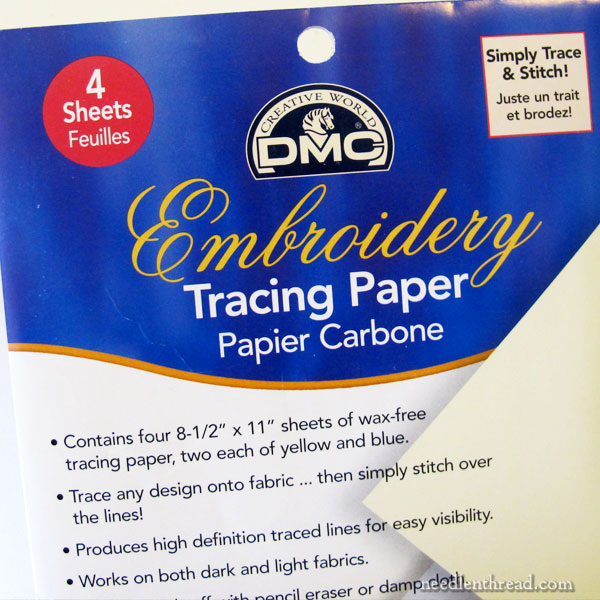
I decided to overcome the first hurdle (dark fabric) by using this product above – it’s DMC’s Embroidery Tracing Paper. You can find it sold with needlework supplies at sewing and craft stores here in the US.
The package contains four 8.5″ x 11″ sheets of transfer paper that works essentially like carbon paper of old. There are two yellow sheets (for dark fabrics) and two blue sheets (for light fabrics).
The non-wax transfer medium on one side of the paper can be brushed, erased, or washed off the fabric when the embroidery is finished.
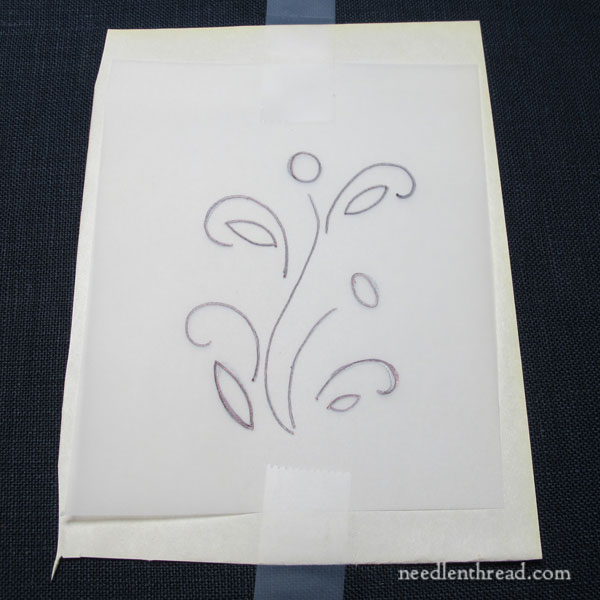
Taking my quickly doodled-up design drawn on regular tracing vellum, I placed a small cut of the transfer paper color-side down on the fabric, then placed my doodle on top of it, and adhered both to the fabric with some very lightly placed scotch tape.
The tape keeps the design from shifting and eliminates having to hold the transfer paper and design sheet in place with my other hand – which could result in smudging some extra transfer paper residue onto the fabric’s surface.
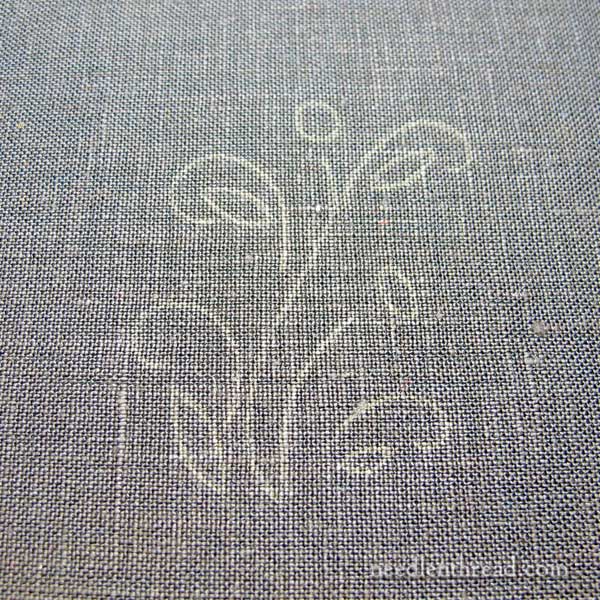
Then, I just took a ball point pen and traced over the design, pressing the transfer medium on the DMC paper onto the fabric.
The transfer – which is on a dark navy blue linen (you thought it was black, didn’t you?) – came out clearly enough.
The image above is under a rather bright light, so the linen looks strangely blackish gray.
The lines from the transfer paper don’t come out bright yellow, even though the color of the transfer medium on the paper is a bright yellow. The transferred design lines come out much lighter, like you see above.
The lines are perfectly visible, but they aren’t sharp, precise lines. They’re a little soft and fuzzy and a little thicker than I generally like, when it comes to design transfer.
It may sound a bit persnickety – after all, the design is on the fabric, and it was done quite painlessly, right?
But this is The Thing: your design transfer has a huge effect on the outcome of your embroidery. The more precise you can make the design transfer, the better.
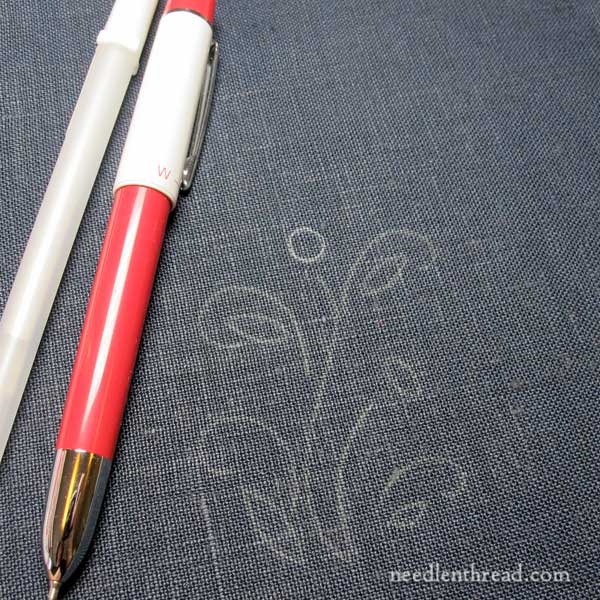
Enter: the Bohin extra-fine ceramic chalk pencil. I do like this thing very much!
It looks like this in the package:
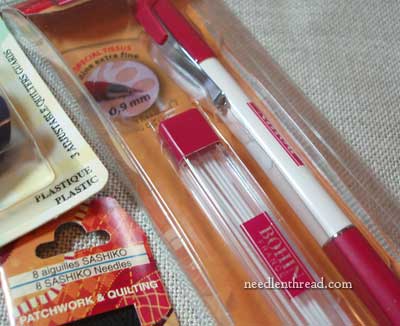
There are different brands of these types of pencils out there, but I’ve had this Bohin one for a while and it’s always been quite trusty.
Bohin makes five refill colors for it, in white, gray, aqua, yellow and pink. The gray works great on white fabric and the white works great on dark fabric. I haven’t really had much use for the other colors.
The lines are nice and fine – much finer than most chalk-type pencils – and they’re more stable than regular chalk lines. They don’t rub off as easily.
So I gave the design on the navy fabric a jolly once-over with the ceramic pencil, and it sharpened up the lines quite nicely.
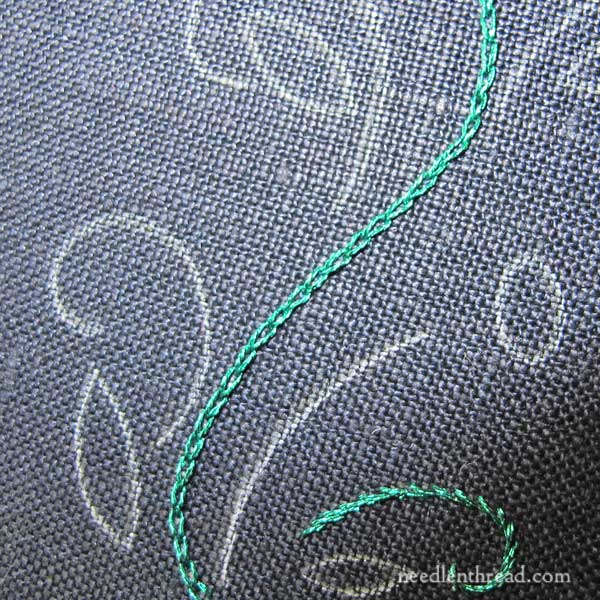
I should have quit there. After all, I had accomplished a small significant thing: the fabric was prepared, the design was transferred, and the project was mounted on stretcher bars, ready to stitch.
But I couldn’t resist trying the metallics.
I don’t use metallics often and I rarely stitch on dark-dark ground fabrics, so this little piece is a challenge – an opportunity to work with a thread I don’t normally work with, that I invariably find difficult to work with, and in colors that are out of my normal comfort range.
Dark fabric. Metallic threads. Stitch hurdles.
Perhaps getting this far wasn’t a Huge Accomplishment, but sometimes, it’s the little steps that make the biggest difference.
Tomorrow, I’m going to show you some exquisite stitchery.
See you then!
Like what you see?
If you enjoyed this article and you’re looking for more inspiration, information, and instruction on hand embroidery, why not sign up for my daily newsletter?
There are all kinds of reasons to have Needle ’n Thread delivered to your inbox – check them out and sign up today!







Nice! And good tips about the tools and transferring designs. Thanks, Mary!
Dear Mary
I do have a Bohin pencil but I don’t often use it but I can see that it works well for dark fabric. I don’t often transfer designs onto dark fabric but your example above is a good tip. I’ve not heard of DMC tracing paper before but with the Bohin pencil you design has come out really clear. I know what you mean about metallic thread not my favourite floss but it looks lovely on the design. Thanks for introducing us to the DMC tracing paper and the Bohin pencil I look forward to the progress on this project and your views on metallic threads.
Regards Anita Simmance
I had wondered about the Bohin pencil – thanks for the review of it. I had to chuckle about “tomorrow I’m going to show you some exquisite embroidery” comment. Every time you show your work, we see exquisite embroidery!
Don’t denigrate ANY accomplishment Mary. We all know there are days when the biggest accomplishment of all is just getting out bed…lol. You overcame a difficulty and accomplished something and that counts big!
I have the bohin mechanical pencil and love it. I’ve used it many times (even though I could have used a regular pencil or chalk pencil) just to get that fineness of line. Metallics aren’t EASY but the end result to me, is worth the aggravation. Is that a light effects metallic in your picture? If so, then making a start with a very finely stitched chain stitch, is not only an accomplishment but a BIG accomplishment. So carry on Mary! You did good!
What metallic thread are you using?
Oh Mary
Where was this article 6 weeks ago when I was in tears over transferring a design onto dark fabric? This is so so much easier than prick and pounce.
Live and learn I suppose “,
Mary, you are a true engineer! Your way of solving problems is great. You consider all options then narrow it down to what makes the most sense for what you’re trying to accomplish,
wow. thanks for sharing it helps me think out my problems.
Mary, your comment about the tasks you did is incorrect IMHO.
1. You started something that you were concerned about, at a time when you were very frustrated with another project.
2. You tried out a new product, the transfer paper.
3. You realized that the first tracing was not as narrow as you wanted, so you introduced a lot of people to the Bohin transfer pencil.
4. You also did a couple of lines with your metallic thread! And the stitching was beautiful.
While jumping up and down might be extreme, you have at least positively accomplished more than enough to keep a big smile on your face!
For those who do not yet have the pencil, you can use a .5 mechanical pencil with the transfer paper to get a sharp line. There are also now mechanical pencils that use a .3 lead, but I find that the .3 leads break very easily, while the .5 leads are quite a bit stronger.
I ve just ordered that pencil ,cant wait to give it a try. Thanks for telling us about it .
Also looking forward to tomorrows lovely stitchery : )
I too would like to know the Metallic threads you are using.
I have all the DMC Diamante threads and find these a million times easier to use than their other metallic threads, although the colour range is smaller.
I hope they make a blue Diamante soon.
Hi, Karen – it is Diamant, and you’re right, it is much easier to use than most metallics. Just today, as I was finishing up this very project, I was pining for a cobalt blue and a peacock blue-green!
Hi Mary,
I love dark fabrics! I use artists white graphite paper, non-oily, but difficult to remove if you make a mistake, and a ballpoint pen to transfer designs. It makes a really fine line that holds up well while embroidering. I look forward to your finished design.
A great post. Thanks for all the transfer info, I have been looking at different pens etc online but haven’t yet decided which to go for! x
oh, thank you for the walkthrough!
I haven’t tried these tools yet but I’ll definitely give them a go when I’ll jump into hand free embroidery 🙂
I don’t use Metallics either, and I used to have quite a strict comfort zone in my colour palettes, I decided to take a few (calculated) risks and I must say it’s very nice to see vibrant, happy pieces on my dowels too.
thank you so so much for being so inspiring and precise! (there’s no such thing as an excess of persnicketiness in my book, as long as it’s justified, and this one surely was!)
I embroider almost exclusively on coloured or dark fabrics, so I appreciate any advice on design transfer techniques for dark fabric. 🙂 I will definitely look into the Bohin chalk pencil!
I’m having “one of those days too” desperately looking for a link to a bog that showed a stitch that could be used in stumpwork to create hair, grass, tree leaves etc. It created a longer, curlier strand than drizzle stitch so it covered quite a big area really quickly. I thought I’d followed a link in one of your posts Mary but maybe not…
As far as I remember, you use stranded thread and untwist it and re-twist tight till it makes a sort of curly cord and then couch it in place.
Would be very grateful if anyone can shed some light on it as I have a project in mind that it will be perfect for?
Hi, Pauhla – I believe what you’re looking for is in this article: https://needlenthread.wpengine.com/2015/04/17th-century-embroidery-needlepainting-nibbles-more.html – it’s in the video, demonstrated by Alison Cole.
That’s it! Thank you Mary!!!
I can’t resist telling you all how happy I am that my nearest fabric and embroidery shop has a new stock of Bohin items. Every sewing and embroidery implement you could need is now made by Bohin so there is no question about the quality, is it worth the price, will it last etc. I trust this brand and now I have it a short walk away. It makes me happy!